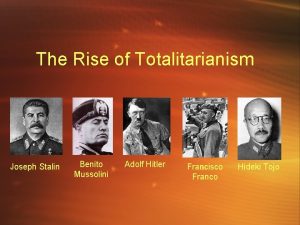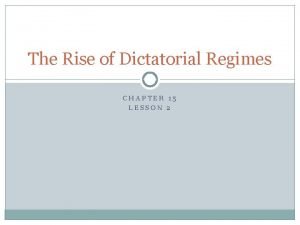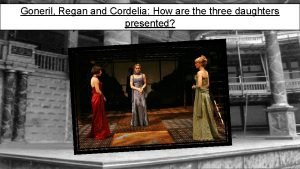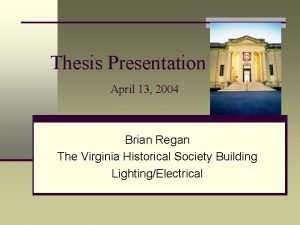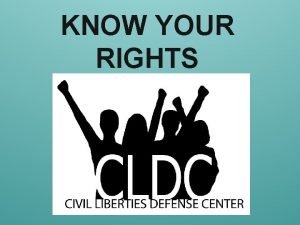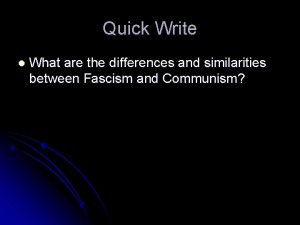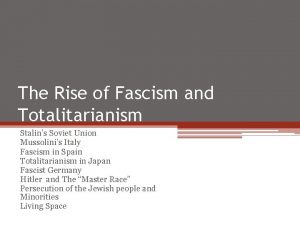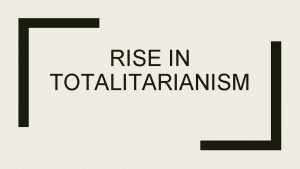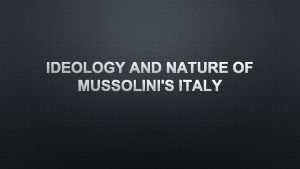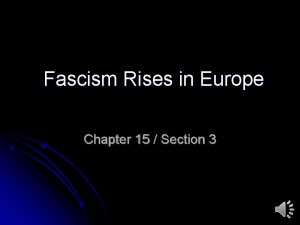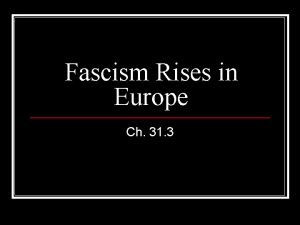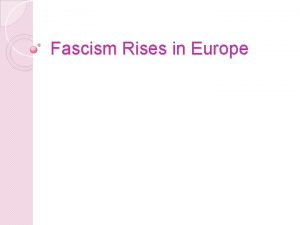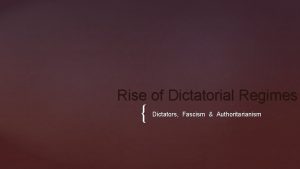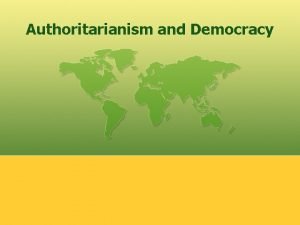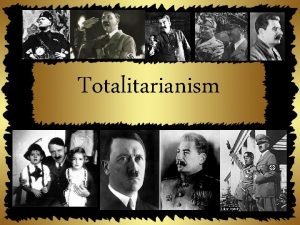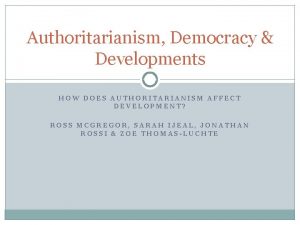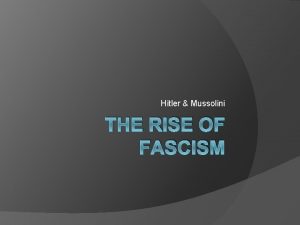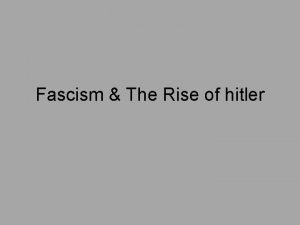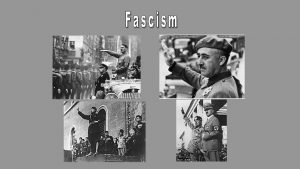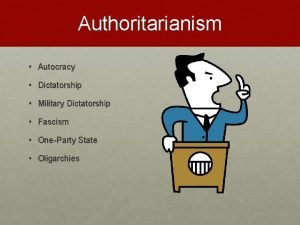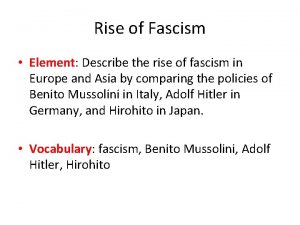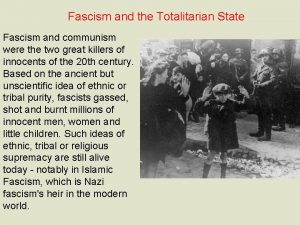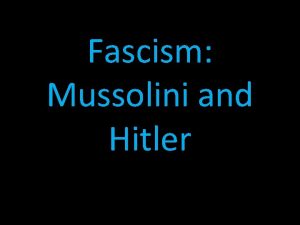The Rise of Fascism and Authoritarianism Mr Regan
























- Slides: 24

The Rise of Fascism and Authoritarianism Mr. Regan

Definition of Fascism n n The twentieth century gave rise to several new forms of government. While in Russia, people turned to Communism during and following World War I, in Italy and Germany, people turned to another form of government known as Fascism. Like the Communists, the Fascists were a misery party (popular during times of widespread suffering or economic depression that left the mainstream parties looking inadequate). Although the Communists and Fascists were sworn enemies, they were actually pretty similar. Or at least that is how it turned out when looking at the Soviet regime. Fascists had no exact ideology (there was no Fascist Karl Marx to write it out) and, unlike Communism, it was not an intellectual movement (in fact it was anti-intellectual). The Fascists tended to glorify violence, think of the welfare of the state first, and ignore the rights of the individual. Fascists stressed nationalism and militarism, and the end goal of their regimes was to have a dictatorship that embodied the spirit of “the people”. Fervent love for the state and not thinking (let propaganda think for you) was encouraged in Fascist regimes as well.

Rise of Fascism in Italy n n n After WWI, Italy was definitely looking for a pick-up: unemployment rates were high, there was a lot of inflation, and there was talk of revolution. Peasants were stealing land, and striking workers and angry industrialists were struggling for control. The upper classes feared a Communist rebellion, social issues had not been addressed, and the peace treaty had made people mad. During this time the first Fascist movement was born. Led by Benito Mussolini, the Fascists denounced liberalism using leftist rhetoric and denounced Marxism b/c of its lack of nationalistic sentiment. They effectively used propaganda and activists (Black Shirts) to spread their message. At first the Fascists were not very successful. In 1921, during the first elections with universal male suffrage the Fascists began to rise to power. The Fascists won 35 seats, and were included in the prime minister Giolitti’s personal coalition.

Rise of Fascism in Italy n n n But instead of just operating by the rules, the Fascists used their Black Shirted activists to plant bombs, beat up other parties, disrupt meetings, and scare people. Then, when the left wing unions called a general strike in 1922, the Black Shirts started to take over town councils by force. In October, they staged a March on Rome. Parliamentary leaders woke up after a while, called for martial law, but the King (Victor Emmanuel III) refused. Mussolini reached Rome, where he was invited to form a cabinet by the King. So Mussolini became the prime minister, and his party won a huge victory in the elections of 1924 b/c of his techniques of intimidation and fraud. Then he began terrorizing the opposition and shooting their leaders. The opposition was unable to respond effectively b/c they were so divided.

Italy Under Mussolini n n By 1925 Mussolini had gotten rid of all his opponents and gained control of the press. He then moved to make his power official by passing a series of law that declared the Duce (leader) of Fascism the head of state w/the right to govern by decree. Opposition parties were outlawed, opponents arrested and the civil services and judiciary branches were purged of any people thought too independent. During this time, Mussolini’s immense propaganda machine created a “Cult of Personality. ” Italians were told to obey the leader and to fight for their country, and were filled with nationalistic pride and confidence. The single-party government reached into every aspect of Italian life. Armed with a militant secret police, the Fascist party kept tight control on the country and soon won thousands of new supporters.

Italy Under Mussolini n n The Fascists didn’t really have a consistent ideology or policy, but they did establish the Corporate State in Italy. In the Corporate State, each sector of production was supposed to be organized into a huge corporation. Each corporation was headed by a party member appointed by the government, and was to establish the policies for the industry and wage scales. Italy never became as orderly as Mussolini promised, but freedom and individual rights were destroyed. Although a quiet intellectual opposition was allowed, thousands of people were exiled or killed for opposing the government.

Italy Under Mussolini n n The government attempted to keep peasants on the land increase the birthrate, but neither campaign was effective. They were, however, able to stop the Mafia in Sicily, drain the marshes near Rome, and build railroads and superhighways. They used these public works programs to combat unemployment, and the (and the benefits of the new things built) gave people a sense of security. Mussolini’s biggest achievement was his agreement with the Vatican, known as the Lateran Agreement (1929). In the agreement, Mussolini recognized Vatican City as an independent state, established religious teaching in public schools, guaranteed that marriage laws would conform to Catholic doctrine, promised to restrict the Protestants and promised to give the Church money to pay for the damage done during Italian unification. The agreement favorably disposed the Church (and many Italian Catholics) towards Mussolini.

Germany After WW I n n After World War I, Germany had a democracy known as the Weimar Republic. It was headed by a President (w/a 7 year term) who oversaw the country but didn’t make day-to-day decisions. The President could call new elections at any time. The Chancellor (elected from the majority party in the Reichstag) ran the country. The Reichstag (Parliament) was formed through direct elections where people voted for a party (not for people) and the % of votes a party received was the % of the seats the party got. Since the Chancellor came from the majority party, if there was no majority party, the President was allowed to appoint a Chancellor.

Germany After WW I n n n At first, the Weimar Republic had a really rough time. The Republic’s first act on November 11, 1918 was to agree to an armistice (which was really a surrender). This armistice was seen as the first failure of the Weimar Republic. After a war that had totally exhausted the country, it was really hard for Germany to bear defeat. The army consequently made up a myth about being “stabbed in the back” by people inside Germany. According to them, it was the left-wing politicians (also Jewish people) that caused their loss. During this time President Hindenburg and Chancellor Ebert ran the country. The democracy seemed on the right track.

Germany After WW I n n Then in 1923 came horrible ultra-inflation! Caused by the French occupation of the Ruhr (industrial heartland) b/c when Germany fell behind in paying the reparations that French seized the German factories, the German workers went on strike, and then, when the gov’t decided to pay the French, money became worthless. This was horrible for people: all their savings disappeared – and was seen as the second failure of the Weimar Republic. Then on November 8/9, 1923, the Beer Hall Putsch occured, led by General Ludendorff and Hitler (unknown at the time). It failed miserably, but Hitler got natopnal press coverage, got out of jail after a really short time, and learned that legality is the way to go (working though the gov’t to destroy it). From 1925 to 1925, though, the Republic does really well! Germany gets admitted into the League of Nations and is back in the international community. Moderate parties are doing well, not the Nazis. But then in 1929 w/the Great Depression everything collapses. Since Germany is dependent on US $, when the US economy crashes so does the German, only worse. Now the “misery parties” begin to come into their own…

The Rise of Fascism in Germany n n One party that made a spectacular rise with the onset of the depression (along with the KPD and SPD) was the Nazi party, led by Adolph Hitler The Nazis attacked democracy, advocated war against Germany’s enemies (Jews, Communists, other nations, etc. ) and had the SA (a street army of brown-shirted storm troopers), the SS (an elite group in black uniforms who were bodyguards and special police), and propaganda to spread their message. With the depression and the failure of the Republic to solve the problems plaguing it (what could it do? ) the Nazis, with their calls for rearmament and stopping the Communists, became more popular. Since the 1930 election gave the Nazis more seats Hitler ran for president in 1932 (though he knew he would lose against Hindenburg). He lost, but he got lots of press coverage, etc.

The Rise of Fascism in Germany n n n Finally, in 1933, Hitler was appointed Chancellor. Almost immediately, he called another election, and through cheating, the Nazis won an even bigger majority. Then (lucky for Hitler) the Reichstag building was set on fire. Hitler blamed it on the Communists, declared a state of emergency (which allowed him to issue all these special laws that ended individual freedoms). But he still didn’t have the 2/3 majority needed to become a dictator. So he sucked up to the Center party and made all these promises to them and was then able to pass the Enabling Act, which gave him, as chancellor, the right to enact all laws w/o the Reichstag for four years.

Germany Under Hitler n n First Hitler moved to consolidate his power by sending all his opponents to concentration camps or putting them in exile, etc. By July 1933 he outlawed all other parties and destroyed the opposition, and by November he had restructured the government and purged the civil service and judiciary, outlawed strikes, and controlled the press (sound familiar – think Mussolini). Then in June 1934 he got rid of all the other leaders of the party and any opposition leaders who were left. When Hindenburg died in August, he declared himself Fuhrer (uniting the Presidency and Chancellorship) and supported the decision through a vote.

Germany Under Hitler n n n Then, all gov’t employees were made appointees of Hitler. New courts were established, strikes were outlawed (the National Labor Front directed all concerns) and the Gestapo (secret police) infiltrated all levels of society. In economics, they were very successful. Public works projects lowered unemployment to a tolerable level, and the gov’t used deficit spending to restore the economy. During this time, propaganda advertised the benefits of the new government. Women were presented as subordinate members of the family (meant for breeding more Aryans). Also, Hitler sucked up to the army by pushing rearmament and gained more direct control of different branches of the government, such as the foreign services.

Germany Under Hitler n n To deal w/the church, Hitler made a concordat with the Vatican in 1933, which gave the state a voice in the appointment of bishops but assured the Church of its authority over Catholic orders and schools. Protestants were given the Evangelical Church under a bishop appointed by Hitler. Most clergy cooperated w/the state, the ones who resisted were arrested. Then there was anti-Semitism. In 1935, the gov’t codified its anti-Semitic beliefs in the Nuremberg Laws and then added many other horrible laws to oppress the Jewish people. In 1938 Kristallnacht occurred after a Jewish boy murdered a German diplomat: Jews were beaten and murdered and their property was destroyed. Gypsies were also attacked.

Authoritarian Regimes in Central Europe n n By 1929, in Central Europe, authoritarian regimes had taken over Hungary, Spain, Albania, Portugal, Lithuania, and Yugoslavia, and by 1936 liberties had also been suppressed in Romania, Austria, Bulgaria, Estonia, Latvia and Greece. For the most part, the new regimes were conservative, Christian and anti-communist, and are sometimes called semi-fascist.

The ideology of Italian fascism was based on a. a socialist government funded on military conquest. b. a radical democracy with a socialist economy. c. full democracy and a capitalist economy. d. nationalism and a communist economy. e. an authoritarian state and a corporate economy.

The Constitution of Weimar Germany helped to undermine the republican form of government by a. providing for rule by a single individual in cases of national emergency. b. favoring the Left over the Right in the political spectrum. c. committing Germany to support all decisions made by the World Court. d. denying some citizens the basic civil rights of a modern democracy. e. using complicated legal language that few people could understand.

Which of the following was a central part of National Socialist (NAZI) ideology? Anticommunism b. Conservatism c. Protestantism d. Utilitarianism e. Syndicalism a.

Which of the following best describes the Nazi Party’s ideal role for “Aryan” women in Germany? a. They were to be mothers, wives, and homemakers. b. They were to serve in equal numbers with men in state and party bureaucracies at all levels. c. They were to have no political or legal rights. d. They were to enjoy economic power equal to that of men. e. They were to be a reserve military force, available for frontline duty when there was a shortage of male soldiers.

Which of the following was originally part of German Nazism but not part of Italian fascism? a. b. c. d. anti-communism anti-Semitism political violence the replacement of a democratically elected government e. a single charismatic leader

One reason the Fascist governments of Benito Mussolini and Adolf Hitler came to power in Italy and Germany was that these nations a. b. c. d. were threatened by the United States. supported civil liberties for all. faced economic and political difficulties. failed to join the League of Nations.

Fascism in Europe during the 1920’s and 1930’s is best described as a a. demonstration of laissez-faire capitalism that promoted free enterprise b. form of totalitarianism that glorified the state above the individual. c. type of economic system that stressed a classless society. d. set of humanist ideas that emphasized the dignity and worth of the individual.

What was one reason the Nazi programs and policies of the early 1930’s appealed to many people in Germany? a. the people were frustrated with their current economic and political situation. b. Germany had been denied membership in the United Nations. c. a coup d’etat had forced communism on the German people. d. the German people feared that the French of the British would soon e. gain control of the Polish corridor.
 Hideki tojo
Hideki tojo Why were italian nationalists outraged after ww1
Why were italian nationalists outraged after ww1 Tricky dick
Tricky dick Sheep become lions
Sheep become lions Rise again and again until lambs
Rise again and again until lambs A union b example
A union b example Pixi maths aiming for grade 5 answers
Pixi maths aiming for grade 5 answers 3:1 ratio
3:1 ratio Regan and cordelia
Regan and cordelia Njucc
Njucc Sources oses xrosvarnham regan theinformation
Sources oses xrosvarnham regan theinformation Brian regan richmond va
Brian regan richmond va Regan gore
Regan gore Ed regan
Ed regan Regan frasier
Regan frasier Bernadette o'regan
Bernadette o'regan Civil liberties defense center
Civil liberties defense center Describe the similarities between fascism and communism
Describe the similarities between fascism and communism Totalitarianism vs fascism
Totalitarianism vs fascism Fascism vs totalitarianism
Fascism vs totalitarianism Authoritarian democracy
Authoritarian democracy Chapter 31 section 3 fascism rises in europe
Chapter 31 section 3 fascism rises in europe Struggle ch 31
Struggle ch 31 Principles of facism
Principles of facism Fascism in italy worksheet answers
Fascism in italy worksheet answers
